AMD Ryzen 9 5980HS Cezanne Review: Ryzen 5000 Mobile Tested
by Dr. Ian Cutress on January 26, 2021 9:00 AM EST- Posted in
- CPUs
- AMD
- Vega
- Ryzen
- Zen 3
- Renoir
- Notebook
- Ryzen 9 5980HS
- Ryzen 5000 Mobile
- Cezanne
CPU Tests: Simulation
Simulation and Science have a lot of overlap in the benchmarking world, however for this distinction we’re separating into two segments mostly based on the utility of the resulting data. The benchmarks that fall under Science have a distinct use for the data they output – in our Simulation section, these act more like synthetics but at some level are still trying to simulate a given environment.
DigiCortex v1.35: link
DigiCortex is a pet project for the visualization of neuron and synapse activity in the brain. The software comes with a variety of benchmark modes, and we take the small benchmark which runs a 32k neuron/1.8B synapse simulation, similar to a small slug.
The results on the output are given as a fraction of whether the system can simulate in real-time, so anything above a value of one is suitable for real-time work. The benchmark offers a 'no firing synapse' mode, which in essence detects DRAM and bus speed, however we take the firing mode which adds CPU work with every firing.
The software originally shipped with a benchmark that recorded the first few cycles and output a result. So while fast multi-threaded processors this made the benchmark last less than a few seconds, slow dual-core processors could be running for almost an hour. There is also the issue of DigiCortex starting with a base neuron/synapse map in ‘off mode’, giving a high result in the first few cycles as none of the nodes are currently active. We found that the performance settles down into a steady state after a while (when the model is actively in use), so we asked the author to allow for a ‘warm-up’ phase and for the benchmark to be the average over a second sample time.
For our test, we give the benchmark 20000 cycles to warm up and then take the data over the next 10000 cycles seconds for the test – on a modern processor this takes 30 seconds and 150 seconds respectively. This is then repeated a minimum of 10 times, with the first three results rejected. Results are shown as a multiple of real-time calculation.
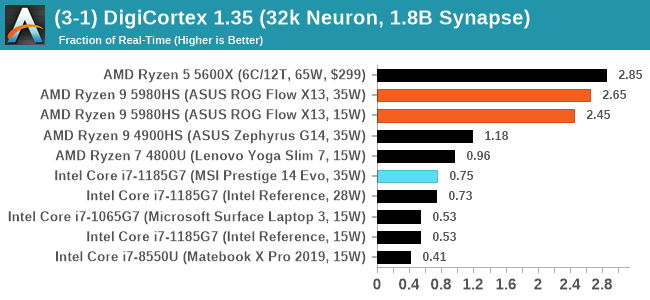
DigiCortex seems to have taken a shine to Zen 3, especially processors with a single chiplet of cores. Intel can't seem to compete here.
Dwarf Fortress 0.44.12: Link
Another long standing request for our benchmark suite has been Dwarf Fortress, a popular management/roguelike indie video game, first launched in 2006 and still being regularly updated today, aiming for a Steam launch sometime in the future.
Emulating the ASCII interfaces of old, this title is a rather complex beast, which can generate environments subject to millennia of rule, famous faces, peasants, and key historical figures and events. The further you get into the game, depending on the size of the world, the slower it becomes as it has to simulate more famous people, more world events, and the natural way that humanoid creatures take over an environment. Like some kind of virus.
For our test we’re using DFMark. DFMark is a benchmark built by vorsgren on the Bay12Forums that gives two different modes built on DFHack: world generation and embark. These tests can be configured, but range anywhere from 3 minutes to several hours. After analyzing the test, we ended up going for three different world generation sizes:
- Small, a 65x65 world with 250 years, 10 civilizations and 4 megabeasts
- Medium, a 127x127 world with 550 years, 10 civilizations and 4 megabeasts
- Large, a 257x257 world with 550 years, 40 civilizations and 10 megabeasts
DFMark outputs the time to run any given test, so this is what we use for the output. We loop the small test for as many times possible in 10 minutes, the medium test for as many times in 30 minutes, and the large test for as many times in an hour.
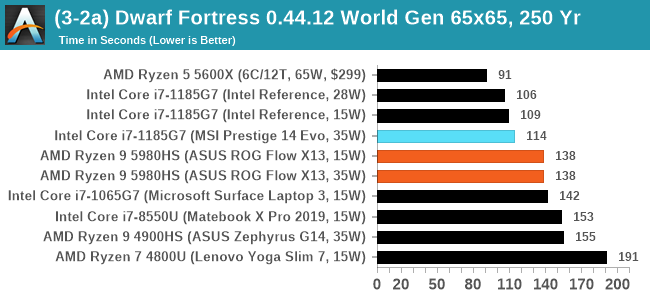
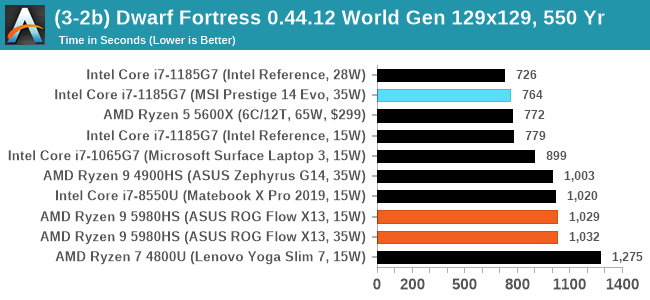
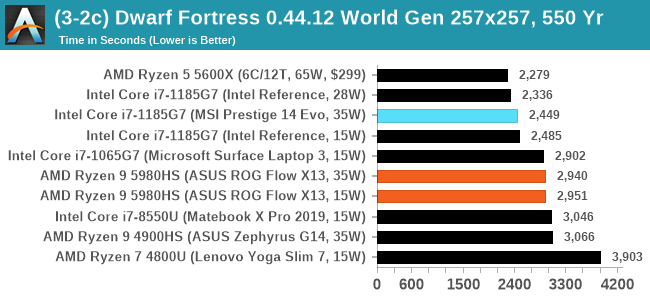
DF has historically been an Intel favorite, and we're not seeing much of a speedup for mobile Zen 3 over mobile Zen 2 here.
Dolphin v5.0 Emulation: Link
Many emulators are often bound by single thread CPU performance, and general reports tended to suggest that Haswell provided a significant boost to emulator performance. This benchmark runs a Wii program that ray traces a complex 3D scene inside the Dolphin Wii emulator. Performance on this benchmark is a good proxy of the speed of Dolphin CPU emulation, which is an intensive single core task using most aspects of a CPU. Results are given in seconds, where the Wii itself scores 1051 seconds.
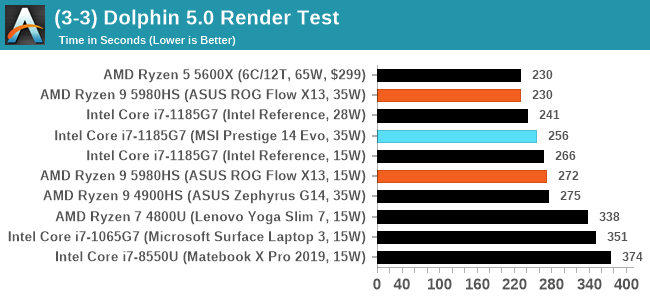
The 35W variant of Cezanne pushes through here, matching the desktop processor, and a sizeable performance jump over the previous generation Renoir.












218 Comments
View All Comments
Stuka87 - Wednesday, January 27, 2021 - link
Really no reason for them to move away from Vega for these chips. Do you also complain that Intel has not changed their IGP for years?The efficiency of Vega is quite good when not OC'ed way past where it should be like in the desktop cards. And it still offers adequate performance for the majority of people looking at a laptop. For anything more you want a discrete card anyway.
Unashamed_unoriginal_username_x86 - Thursday, January 28, 2021 - link
Just on the Intel point, it's worth noting that they've had to develop GPU IP specifically for their CPUs. The paradigm has changed with the advent of Xe scalable, but even then the first product released with Xe was a CPU. Obviously AMD is disadvantaged with RTG not being as tightly nit as Intel's GPU groupIGTrading - Tuesday, January 26, 2021 - link
Amazing execution from AMD.Unfortunately, the only way they could gain some significant market share would be if they manage to source enough capacity from TSMC.
The demand for AMD CPUs in the market is huge.
At Amazon, AMD's chips come with a +50% price premium on a regular basis. SONY & Microsoft are going nuts trying to get more chips from AMD.
If AMD managed to negotiate well their cut from TSMC, we should see an explosion of AMD's revenue in 2021.
The new crypto boom will only propel AMD's ASPs even higher, although it will annoy the IT enthusiasts.
Great piece, Ian! Thanks.
Deicidium369 - Wednesday, January 27, 2021 - link
Not a question of capacity - it's the fact that TSMCs fragile long supply chain is broken and limited resources have to be allocated - and AMD is contractually obligated to reach delivery targets for the Console SOCs. They have to use the limited resources to provide the ultra high volume, ultra low margin SOCs over their high margin PC GPUs and CPUs.In this case, it's not AMD's fault - it's an issue with TSMC
Spunjji - Thursday, January 28, 2021 - link
"TSMCs fragile long supply chain is broken"---citation needed---
Qasar - Thursday, January 28, 2021 - link
---will never see it---e36Jeff - Tuesday, January 26, 2021 - link
Minor quibble, the chart at the bottom of the first page lists the Flow X13's memory speed as LPDDR4-3267 rather than 4267.Silma - Tuesday, January 26, 2021 - link
It's one thing to develop great processors, it's entirely another thing to effectively ship them.I would have liked to purchase a Zen 3 processors for my new PC, but I had to make do with a 3700X.
Would have been interested by an RTX 3070 or an AMD latest gen graphic card, but again, they only seem to exist in the hands of testers, YouTubers and twitchers.
Let's see if AMD can really ship a decent number of Zen 3 mobile CPUs.
bji - Tuesday, January 26, 2021 - link
All your problems are easily solved. Just go to MicroCenter!Qasar - Tuesday, January 26, 2021 - link
and if there is no microcenter near you, then what ?